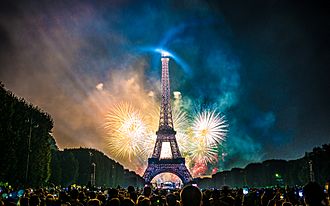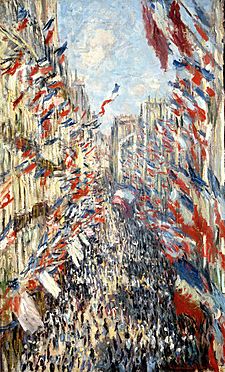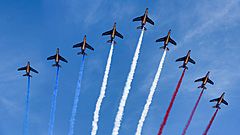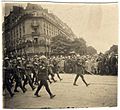Bastille Day facts for kids
Quick facts for kids Bastille Day |
|
|---|---|

|
|
| Also called | French National Day (Fête nationale) The Fourteenth of July (Quatorze juillet) |
| Observed by | France |
| Type | National Day |
| Significance | Commemorates the Storming of the Bastille on 14 July 1789, and the unity of the French people at the Fête de la Fédération on 14 July 1790 |
| Celebrations | Military parades, fireworks, concerts, balls |
| Date | 14 July |
| Frequency | annual |
Bastille Day is the common name given in English-speaking countries to the national day of France, which is celebrated on 14 July each year. In French, it is formally called Fête nationale.
The French National Day is the anniversary of Storming of the Bastille on 14 July 1789, a turning point of the French Revolution, as well as the Fête de la Fédération that celebrated the unity of the French people on 14 July 1790. Celebrations are held throughout France. One that has been reported as "the oldest and largest military parade in Europe" is held on 14 July on the Champs-Élysées in Paris in front of the President of the Republic, along with other French officials and foreign guests.
Contents
Events and traditions of the day
The Bastille Day Military Parade opens with cadets from the École polytechnique, Saint-Cyr, École Navale, and so forth, then other infantry troops, then motorized troops; aircraft of the Patrouille de France aerobatics team fly above. In recent times, it has become customary to invite units from France's allies to the parade; in 2004 during the centenary of the Entente Cordiale, British troops (the band of the Royal Marines, the Household flying overhead. In 2007 the German 26th Airborne Brigade led the march followed by British Royal Marines. In 2013, Malian soldiers opened the parade, following the Franco-Malian military Operation Serval. Members of the United Nations' MINUSMA forces also took part in the parade, including soldiers from twelve other African countries, notably Chad. United Nations Secretary General Ban Ki-moon attended the parade alongside French President François Hollande.
The president gives an interview to members of the press, discussing the situation of the country, recent events and projects for the future. Nicolas Sarkozy, elected president in 2007, chose not to give it. François Hollande, elected president in 2012, reinstated it.
History
Storming of the Bastille
On May 19, 1789, Louis XVI convened the Estates-General to hear their grievances. The deputies of the Third Estate representing the common people (the two others were the Catholic Church and nobility) decided to break away and form a National Assembly. On June 20 the deputies of the Third Estate took the Tennis Court Oath, swearing not to separate until a constitution had been established. They were gradually joined by delegates of the other estates; Louis XVI started to recognize their validity on 27 June. The assembly renamed itself the National Constituent Assembly on 9 July, and began to function as a legislature and to draft a constitution.
In the wake of the July 11th dismissal of Jacques Necker, the people of Paris, fearful that they and their representatives would be attacked by the royal military, and seeking to gain ammunition and gunpowder for the general populace, stormed the Bastille, a fortress-prison in Paris which had often held people jailed on the basis of lettres de cachet, arbitrary royal indictments that could not be appealed. Besides holding a large cache of ammunition and gunpowder, the Bastille had been known for holding political prisoners whose writings had displeased the royal government, and was thus a symbol of the absolutism of the monarchy. As it happened, at the time of the siege in July 1789 there were only seven inmates, none of great political significance.
When the crowd—eventually reinforced by mutinous gardes françaises—proved a fair match for the fort's defenders, Governor de Launay, the commander of the Bastille, capitulated and opened the gates to avoid a mutual massacre. However, possibly because of a misunderstanding, fighting resumed. Ninety-eight attackers and just one defender died in the actual fighting, but in the aftermath, de Launay and seven other defenders were killed, as was the 'prévôt des marchands' (roughly, mayor) Jacques de Flesselles.
Shortly after the storming of the Bastille, on 4 August feudalism was abolished and on 26 August, the Declaration of the Rights of Man and of the Citizen was proclaimed.

Fête de la Fédération
The Fête de la Fédération on the 14 July 1790 was a huge feast and official event to celebrate the uprising of the short-lived constitutional monarchy in France and what people considered the happy conclusion of the French Revolution. The event took place on the Champ de Mars, which was at the time far outside Paris. The place had been transformed on a voluntary basis by the population of Paris itself, in what was recalled as the Journée des brouettes ("Wheelbarrow Day").
A mass was celebrated by Talleyrand, bishop of Autun. The popular General Lafayette, as captain of the National Guard of Paris and confidant of the king, took his oath to the constitution, followed by King Louis XVI. After the end of the official celebration, the day ended in a huge four-day popular feast and people celebrated with fireworks, as well as fine wine and running through the streets in order to display their great freedom.
Origin of the present celebration
On 30 June 1878, a feast had been arranged in Paris by official decision to honour the French Republic (the event was commemorated in a painting by Claude Monet). On 14 July 1879, another feast took place, with a semi-official aspect; the events of the day included a reception in the Chamber of Deputies, organised and presided over by Léon Gambetta, a military review in Longchamp, and a Republican Feast in the Pré Catelan. All through France, Le Figaro wrote, "people feasted much to honour the storming of the Bastille".
On 21 May 1880, Benjamin Raspail proposed a law to have "the Republic choose the 14 July as a yearly national holiday". The Assembly voted in favour of the proposal on 21 May and 8 June. The Senate approved on it 27 and 29 June, favouring 14 July against 4 August (honouring the end of the feudal system on 4 August 1789). The law was made official on 6 July 1880, and the Ministry of the Interior recommended to Prefects that the day should be "celebrated with all the brilliance that the local resources allow". Indeed, the celebrations of the new holiday in 1880 were particularly magnificent.
Bastille Day Military Parade
The Bastille Day Military Parade is the French military parade that has been held on the morning of 14 July each year in Paris since 1880. While previously held elsewhere within or near the capital city, since 1918 it has been held on the Champs-Élysées, with the evident agreement of the Allies as represented in the Versailles Peace Conference, and with the exception of the period of German occupation from 1940 to 1944. The parade passes down the Champs-Élysées from the Arc de Triomphe to the Place de la Concorde, where the President of the French Republic, his government and foreign ambassadors to France stand. This is a popular event in France, broadcast on French TV, and is the oldest and largest regular military parade in Europe. In some years, invited detachments of foreign troops take part in the parade and foreign statesmen attend as guests.
Smaller military parades are held in French garrison towns, including Toulon and Belfort, with local troops.
Bastille Day celebrations in other countries
-
- Liège celebrates the Bastille Day each year since the end of the First World War, as Liège was decorated by the Légion d'Honneur for its unexpected resistance during the Battle of Liège.
- Czech Republic
- Since 2008, Prague is hosting French market "Le marché du 14 juillet" offering traditional French food and wine as well as music. The market takes place at the Kampa island, usually between 11th and 14th of July.
-
- Budapest's two-day celebration is sponsored by the Institut de France.
-
- The Auckland suburb of Remuera hosts an annual French themed Bastille Day street festival.
-
- Franschhoek's week-end festival has been celebrated for the last 15 years. (Franschhoek, or 'French Corner,' is situated in the Western Cape.)
The French Consulate in Cape Town also celebrate by throwing an official party for the French Community and local officials.
-
- London has a large French contingent, and celebrates Bastille Day at various locations including Battersea Park.
- Over 50 U.S. cities conduct annual celebrations:
-
- Baltimore has a large Bastille Day celebration each year at Petit Louis in the Roland Park area of Baltimore City.
- Boston has a celebration annually, hosted by the French Cultural Center for over 35 years. Recently, the celebration took place in The Liberty Hotel, a former city jail converted into a boutique hotel, though more often the festivities occur in Boston's Back Bay neighborhood, near the Cultural Center's headquarters. The celebration typically includes francophone musical performers, dancing, and French cuisine.
- Chicago has hosted a variety of Bastille Day celebrations in a number of locations in the city, including Navy Pier and Oz Park. The recent incarnations have been sponsored in part by the Chicago branch of the French-American Chamber of Commerce and by the French Consulate-General in Chicago.
- Dallas's Bastille Day celebration, "Bastille On Bishop", began in 2010 and is held annually on July 14th in the Bishop Arts District of the North Oak Cliff neighborhood, southwest of downtown just across the Trinity River. Dallas' French roots are tied to the short lived socialist Utopian community, La Réunion, formed in 1855 & incorporated into the City of Dallas in 1860.
- Houston has a celebration at La Colombe d'Or Hotel. It is hosted by the Consulate General of France in Houston, The French Alliance, the French-American Chamber of Commerce, and the Texan-French Alliance for the Arts.
- Milwaukee's four-day street festival begins with a "Storming of the Bastille" with a 43-foot replica of the Eiffel Tower.
- Minneapolis has a celebration in Uptown with wine, French food, pastries, a flea market, circus performers and bands. Also in the Twin Cities area, the local chapter of the Alliance Française has hosted an annual event for years at varying locations with a competition for the "Best Baguette of the Twin Cities."
- Montgomery, Ohio has a celebration with wine, beer, local restaurants' fare, pastries, games and bands.
- New Orleans has multiple celebrations, the largest in the historic French Quarter.
- New York City has numerous Bastille Day celebrations each July, including Bastille Day on 60th Street hosted by the French Institute Alliance Française between Fifth and Lexington Avenues on the Upper East Side of Manhattan, Bastille Day on Smith Street in Brooklyn, and Bastille Day in Tribeca. The Empire State Building is illuminated in blue, white and red.
- Orlando has a boutique Bastille Day street festival that began in 2009 in the Audubon Park Garden District and involves champagne, wine, music, petanque, artists, and street performers.
- Philadelphia's Bastille Day, held at Eastern State Penitentiary, involves Marie Antoinette throwing locally manufactured pastries at the Parisian militia, as well as a re-enactment of the storming of the Bastille.
- Sacramento, California conducts annual "waiter races" in the midtown restaurant and shopping district, with a street festival.
- San Francisco has a large celebration in the city's historic French Quarter in downtown.
- Seattle's Bastille Day Celebration, held at the Seattle Center, involves performances, picnics, wine and shopping.
- St. Louis has annual festivals in both the Soulard neighborhood and the former French village of Carondelet, Missouri which include reenactments of the beheading of Marie Antoinette and Louis XVI, as well as reconstructed French fur trading posts.
One-time celebrations
- 1979: A concert with Jean Michel Jarre on the Place de la Concorde in Paris attracted one million people, securing an entry in the Guinness Book of Records for the largest crowd at an outdoor concert.
- 1989: France celebrated the 200th anniversary of the French Revolution, notably with a monumental show on the Champs-Élysées in Paris, directed by French designer Jean-Paul Goude. President François Mitterrand acted as host for invited world leaders.
- 1990: A concert with Jean Michel Jarre was held at La Défense in Paris.
- 1994: The military parade was opened by Eurocorps, a newly created European army unit including German soldiers. This was the first time German troops entered in France since 1944, sealing the definitive Franco-German reconciliation.
- 1995: A concert with Jean Michel Jarre was held at the Eiffel Tower in Paris.
- 1998: Two days after the French football team became World Cup champions, huge celebrations took place nationwide.
- 2004: To commemorate the centenary of the Entente Cordiale, the British led the military parade with the Red Arrows flying overhead.
- 2007: To commemorate the 50th anniversary of the Treaty of Rome, the military parade was led by troops from the 26 other EU member states, all marching at the French time.
- 2014: To commemorate the 100th anniversary of the beginning to the First World War, representatives of 80 countries who fought during this conflict were invited to the ceremony. The military parade was opened by 76 flags representing each of these countries.
- 2017: To commemorate the 100th anniversary of the United States of America's entry into the First World War, French President Emmanuel Macron invited American President Donald Trump to celebrate a centuries-long transatlantic tie between the two countries.
Interesting facts about Bastille Day
- In 1790 the Bastille prison key was given to George Washington as a gift from Marquis de la Fayette and is on display at Mount Vernon, George Washington's home.
- In 2014 Barack Obama gave François Hollande a table as a gift, which was made with some wood from an Oak tree at Mount Vernon. It included a replica of the Bastille key in the center.
- When they stormed the Bastille there were only 7 prisoners there. The Bastille was capable of holding 50.
- There are many fun things to do on Bastille Day, especially in Versailles and at the Palace of Versailles where they have many activities and over 50,000 tourists.
- The Bastille Day Military Parade held in Paris is the oldest in Europe.
- Voltaire was once a prisoner in the Bastille.
- After the Bastille was demolished souvenirs of the fortress were transported around France and displayed as icons of the overthrow of despotism.
Related pages
Images for kids
-
The French President traditionally welcomes honorary guests for the parade (here: Donald Trump in 2017)
-
Horseman of the Republican Guard during the 2007 military parade on the Champs-Élysées
-
Surgeon general inspector Dominique Vallet, head of the Laveran military medical school, at the ceremonies for Bastille Day in Marseille, 2012
See also
 In Spanish: Fiesta Nacional de Francia para niños
In Spanish: Fiesta Nacional de Francia para niños











